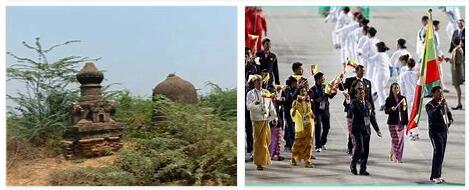Demography and economic geography. – State of Southeast Asia. The International Monetary Fund (IMF), reporting the provisional results of the 2014 census (the first in thirty years), reports a population of 51,486,253 residents, A significantly lower figure than that calculated by previous estimates; the UNDESA (United Nations Department of Economic and Social Affairs) for 2014 is 53,718,958 residents. In 2013, Myanmar recorded a Human Development Index (HDI) of 0.524, ranking among the countries with a low HDI. However, the value of the indicator, in the period 1980-2013, grew by 59.6%, as did all its components: life expectancy at birth, which increased by 10.2 years, the average years of schooling, increased by 2.3, and those of education forecast, increased by 2.6. Despite these advances, living conditions have not improved for rural dwellers. The World Bank (WB) estimated that, in 2009-10, 37.5% of the population was still living in poverty.
Since 2011, following changed political conditions, Myanmar has undertaken a series of reforms to attract foreign investment and reintegrate itself into the global economy: the ‘controlled fluctuation’, in 2012, of the Burmese kyat ; the operational independence of the Central Bank in 2013; an anti-corruption law, again in 2013. Thanks to the abundance of natural resources, a young workforce and proximity to the dynamic Asian economies, the country has attracted foreign investments in the energy sector, in the clothing industry, in technology information and in the food and drink sector.
Foreign direct investment (FDI) increased from $ 1.9 billion in fiscal 2011 to $ 2.7 billion in fiscal 2012. The aforementioned reforms already seem to be paying off: the economy is estimated by the World Bank in growth of 8.3% in fiscal year 2013-14, driven by the construction, manufacturing and service sectors. Nonetheless, per capita GDP (calculated on the census data cited above) is estimated at around $ 1105, settling on one of the lowest values in East Asia and the Pacific.
Politics. – The reform process initiated in the early 2000s by the military junta, in power since 1962, continued, with ups and downs, in the following years. After the brutal repression of the popular protests in 2007, which the Buddhist monks had become animators of, in February 2008 a new Constitution was passed which provided for a presidential government and effectively sanctioned the pre-eminent role of the military to which it was reserved, among other things. other, the appointment of 25% of the seats in both the upper and lower chambers. In November 2010, the first parliamentary elections after those of 1990 were called.
Boycotted by the National League for Democracy (NLD), the largest opposition party led by Nobel Peace Prize Aung San Suu Kyi, and considered by many international observers a farce, they sanctioned the victory of the ruling party, Union solidarity and development party (USDP); in the following February Thein Sein (former prime minister since 2007) was appointed president. During 2011, the new executive took significant measures: many political prisoners were released, media censorship easedand negotiations were promoted with armed ethnic minority groups. Aung San Suu Kyi was released and the electoral rules were changed to allow her and her party to participate in the April 2012 by-election.
The polls marked the triumph of the NLD, which won 43 of the 46 seats up for grabs, and Aung San Suu Kyi was elected deputy with over 80% of the vote. Although Parliament remained under the control of the military, the undoubted steps forward were positively evaluated by the international community: in 2013 the EU lifted the sanctions imposed on the country, with the exception of the arms embargo, and the USA also decreed them. a reduction. At the end of 2014, however, the attempts at dialogue between the government and the opposition seemed to stall in the face of the executive’s firm refusal to modify the Constitution in a democratic sense, while in October 2015 the government signed a ceasefire agreement with eight armed groups of ethnic minorities.
